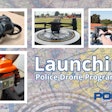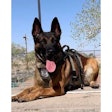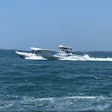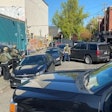Graffiti continues to be used as a written form of communication between street ganges. An observant patrol officer, police investigator, probation/parole officer, school teacher and gang member can read graffiti and collect valuable information about past, current and future gang activities.
Graffiti can serve several functions for the street gangsters. Among other things, it can be used to mark off turn boundaries, be a way to give insults to rival gangs, act as a warning of impending death, list fallen comrades, announce the presence of a gang in a certain area of the city or show gang alliances.
Gang Expression
A common way to miss the valuable information within graffiti is to not consider it as the written form of the gang language. Each type of gang may select a few phrases, words, numbers or symbols to represent its gang. These unique markings can be the key used to identify a particular gang member, just as a moniker will identify a particular gang member. The written language takes on a particular personality, just as the gang does.
One particular type of graffiti which is often ignored and misread is attributed to the groups know as "tag crews" or "graffiti artists" (see "In the Hood," March '98). These gangs, which originated in the New York area compiled an impressive portfolio of subway and train art. The trend spread West during the 1980s and now has become an international phenomenon. The members of these groups often clain they are not gang members because they aren't involved in the violent crimes associated with some of the well-known street gangs.
A good universal definition for a gang is: three or more people, bound by association and involved in crime (misdemeanor or felony). Keeping this in mind, it is easy to see how these groups fall into the gang category.
Seeking Recognition
Tag crew members are interested in one thing only, and that is recognition, first for their crew and secondly for themselves. Often, calling themselves graffiti artists, these crews can be responsible for thousands of dollars worth of damage to buildings, billboards, train cars, buses, walls, freeway overhead signs, overpasses and you name it.
Tag crews can have contest with other crews. The goal is to spread your crew's name on as many places as possible, within a specified amount of time. Usually, a boundary is set. The location boundaries can be a city limits or a freeway system within a certain city.
In the Los Angeles area, some crews have chosen the buses used for public transportation. The time limit can be a few days, like a weekend, or up to a week. The crew that gets its name "up" the most wins. This crew gets the most recognition and most fame within the tagger subculture. The concept is east to understand; the result can lead to millions of dollars work of misdemeanor damage, nationally. Since the crimes are mostly misdemeanors, tag crews are not given the police attention violent street gangs receive.
This can present a problem for local police and sheriff's investigators. Our resources are allocated where needed. If there is a violent local street gang or drug problem, available police resources will go there. Tagger crews, for the most part try to stay away from the ritual street violence that gangs have adopted. However, if a member of the tag crew is victimized by a street gang or another crew, some type of retaliation will follow. This leads, of course, to a violent confrontation between the two groups. These types of incidents can lead to a local gang war between two groups that have never fought before.
Many taggers who claim they do not want to get involved in the gang scene will also carry concealed firearms. These taggers claim they need the guns for protection only. Do not assume that taggers are always unarmed.
[PAGEBREAK]
Increase In Size
Some tag crews have gotten so large that subgroups develop. It has gotten to the point where telephone area codes are being used to identify the subgroups. This emergence of subgroups is similar to the development of "sets" in Blood and Crip gangs or the "cliques" within Hispanic gangs. Tag crews also migrate, just like other street gangs.
They can easily develop new tag crews in other countries and states. These new groups will have a tendency to have conflicts with the locally established street gangs. Tag crews can be as small as three or four and as large as 300 to 400.
No one knows the exact number of taggers in the United States. One thing for sure is that tagging phenomenon is worldwide. Taggers have placed their graffiti in the Chunnel (tunnel beneath the English Channel), on statues in Europe, and freight train cars throughout the world.
The tag crews have also broken the race and gender barriers that still exist for many street gangs. Taggers can be as young as 13 or 14 and most are between the 15 to 18 age group. Tag crew members have come from the ranks of street gangs, as well. Some gang members have joined in an effort to escape gang violence.
Most tag crews do not claim turf. They have the flexibility to go anywhere they want, to place their graffiti or "tag." The method of travel for many taggers is the public bus system, but the use of a personal vehicle is also very popular.
Technique
Many taggers will have a photo album of their work. Some even have a sketch book where they will draw and design their work before placing it on a wall. Almost all taggers use spray paint as their first choice of medium. As a result, a serious tagger will also have a variety of spray paint tips, to control the width and amount of paint that is sprayed. Almost any type of spray paint will be used, but the most popular brand is "Krylon."
Some cities have special ordinances which require local retailers to keep the spray paint in locked cabinets, behind the sales counter, because taggers can also "rack" or steal their paint.
Tag crew members can spray up a wall with their crew name and moniker or "tag" and a few are talented enough to design and paint large murals, often called "piecers," These can be larger and complex works of art. Most of the illegible tagger graffiti is completed by other crew members, called "writers."
Some taggers specialize in placing their graffiti in high locations, such as freeway overhead signs and billboards. This is called going to the heavens." Some taggers try and look for the most remotely accessible areas because many people will see their graffiti and it will also be very difficult to remove (buffing). Other taggers will specialize in "mobbing" buses. Here, a small group of crew will literally assault a bus. Some holds the rear door open, preventing the bus from leaving. The other members will start spray painting the bus. The entire assault takes only a moment or two but the damage is done. Some taggers will hang out of a window, seven or eight stories high, to place their graffiti. Yes, even parked marked police units have been hit.
Other commonly used tools can be broad tip markers, paint, sticks, and etching tools. Window etching has become very popular amongst the bus riders. Etching on store display windows in malls can cost the owner several thousand dollars in replacement costs. Tag crews use graffiti as a source of acknowledgement and fame. Their graffiti is not street art.
Be safe!
Al Valdez is an investigator with the Orange County( Calif.) District Attorney's Office and author of the book, Gangs.











